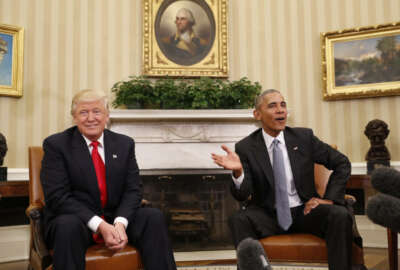The White House has a goal: to improve upon the 2008 presidential transition, widely acknowledged as the smoothest exchange of power between administrations in U.S. history. It’s been planning how best to accomplish that goal for most of the year, and now it’s time to execute.
“The President was grateful for the time and care put into the 2008 transition by President Bush’s Administration,” a Nov. 10 White House fact sheet said. “That is why he directed his team last year to make a smooth transition between administrations a top priority of his final year in office even as he remained committed to using every remaining day of his presidency to deliver on his agenda for the American people.”
Meanwhile, President-elect Donald Trump revealed the executive committee of his transition team. It includes:
- Rep. Lou Barletta (R-Pa.)
- Rep. Marsha Blackburn (R-Tenn.)
- Florida Attorney General Pam Bondi
- Rep. Chris Collins (R-N.Y.)
- Jared Kushner
- Rep. Tom Marino (R-S.C.)
- Rebekah Mercer
- Steven Mnuchin
- Rep. Devin Nunes (R-Calif.)
- Anthony Scaramucci
- Peter Thiel
- Donald Trump Jr.
- Eric Trump
- Ivanka Trump
- RNC Chairman Reince Priebus
- Trump Campaign CEO Stephen K. Bannon
Trump’s transition team is reaching out to agencies to begin studying briefings provided to help the incoming administration catch up to speed.
“During the 73-day period between Election Day and Inauguration Day, the President-elect will deploy Agency Review Teams to each federal agency to ensure a smooth transition between administrations,” said the presidential transition page of GreatAgain.gov.
But the surprising results of the election may have been the first speed bump on the road to the new administration.
“Unfortunately, I was speaking with a senior transition official at the White House recently who said they weren’t taking the prospects of a Trump presidency very seriously, so didn’t really start dealing with the Trump transition team. I think they’re waking up to a new reality today,” Robert Shea, former White House staff member and a fellow at the National Academy of Public Administration, told the Federal Drive with Tom Temin on Nov. 9.
However, Shea said that the transition effort is moving ahead smoothly and efficiently on the individual agency level.
“To my understanding, the Trump presidential transition is very professionally run; they’re taking their duties extremely seriously. There are teams assigned to each agency that have been studying what policies and practices they need to take a look at on day one,” he said.
Those policies and practices include a broad scope of information, including “organizational charts, budget materials, briefings on key agency priorities and areas of responsibility, and other materials describing the essential functions of that agency,” according to the White House fact sheet.
Officials are also receiving daily briefings from the intelligence community. The government is also undertaking two interagency exercises to demonstrate how agencies respond to domestic incidents.
In addition to catching up on agency actions, Trump’s transition team is also vetting candidates to replace the more than 4,000 political appointees that will soon be vacating some of the top posts in the government.
“Finding qualified people to fill these jobs is an enormous undertaking, but it is critically important to making the federal government work effectively for the American public,” Trump’s transition website said.
The White House fact sheet said that the General Services Administration, Presidential Personnel Office and White House IT created an online human resources application to streamline this process.
“This new system can serve as a single tool for processing a candidate from application through appointment, rather than the multiple systems used at the beginning of the current Administration,” it said. “After the Inauguration, this new tool can be utilized by the incoming President to replace the legacy system currently used by PPO, allowing the incoming Administration to use the same tool and processes before and after the Inauguration. It can also be more easily tailored to the specific policies and processes the new Administration decides to adopt.”
Read the latest news about the incoming administration on our Tracking the Transition page.
Copyright
© 2024 Federal News Network. All rights reserved. This website is not intended for users located within the European Economic Area.
